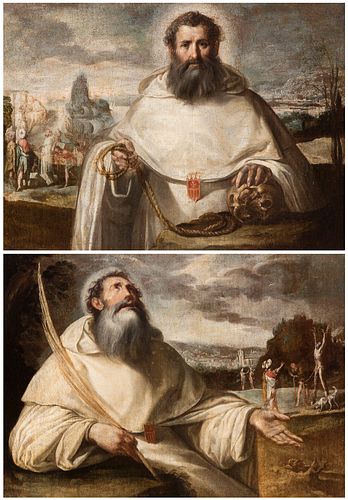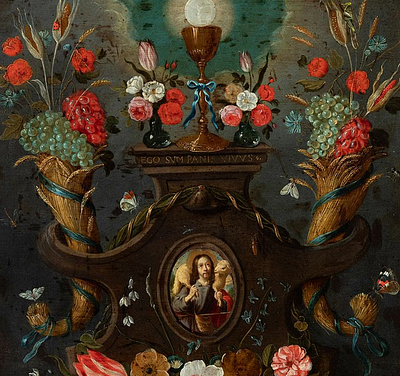ANTONIO DEL CASTILLO Y SAAVEDRA (Cordoba, 1616 - 1668). “San Pedro Armengol” and “San Serapio”. Oil on canvas (x2).
Lot 29
About Seller
Setdart Auction House
Carrer Aragó 346
Barcelona
Spain
Setdart Subastas was born in 2004 and is currently the first online art auction in Spain with solidity, prestige and reliability guaranteed by our more than 60,000 users. Setdart has a young, dynamic and enterprising team ready to successfully manage the purchase and sale of art works through custom...Read more
Estimate:
EUR€20,000 - EUR€25,000
$21,505.38 - $26,881.72
Absentee vs Live bid
Two ways to bid:
- Leave a max absentee bid and the platform will bid on your behalf up to your maximum bid during the live auction.
- Bid live during the auction and your bids will be submitted real-time to the auctioneer.
Bid Increments
| Price | Bid Increment |
|---|---|
| EUR€0 | EUR€10 |
| EUR€200 | EUR€25 |
| EUR€500 | EUR€50 |
| EUR€1,000 | EUR€100 |
| EUR€3,000 | EUR€200 |
| EUR€5,000 | EUR€500 |
| EUR€10,000 | EUR€1,000 |
| EUR€20,000 | EUR€2,000 |
| EUR€50,000 | EUR€5,000 |
About Auction
By Setdart Auction House
Sep 21, 2021
Set Reminder
2021-09-21 10:00:00
2021-09-21 10:00:00
America/New_York
Bidsquare
Bidsquare : 21st September - ARAS JÁUREGUI Private Collection - Old Masters, 19th & 20th Century
https://www.bidsquare.com/auctions/setdart-auction-house/21st-september---aras-j-uregui-private-collection---old-masters-19th-20th-century-7429
Setdart Auction House sofia@setdart.com
Setdart Auction House sofia@setdart.com
- Lot Description
ANTONIO DEL CASTILLO Y SAAVEDRA (Cordoba, 1616 - 1668). “San Pedro Armengol” and “San Serapio”. Oil on canvas (x2). It presents restorations and repainting. Measurements: 55 x 41 cm (x2); 46 x 61 cm (frame, x2). It is probable that these works belong to an early period of Antonio del Castillo's painting, since in 1642 he was contracted to make several paintings referring to the order of the Mercedarians, which would be destined for the main altar of the convent of Nuestra Señora de Mercedes Outside the Walls. This group of paintings consisted of a representation of Saint Peter Nolasco receiving the habit, and four other smaller ones depicting Saint Armengol, Saint Serapio, Saint María del Socorro and Saint Colaxia. In this particular case, the works presented here show in each case a religious dressed in the habits of the Mercedarians, and bearing various iconographic attributes that identify them as Saint Peter Armengol and Saint Serapius. Saint Peter, set in a landscape, faces the viewer in the centre of the composition, holding a rope in his left hand and resting his right hand on a skull. These attributes allude to the miracle in which the saint was saved from the gallows by the Virgin. A miracle that is represented in the work, in the left area of the last plane, where the figure of the saint can be seen, accompanied by several men in Arab costumes, and finally in a higher plane, the figure of the Virgin. The work depicting Saint Serapius has a similar composition in terms of the conception of the pictorial distribution. However, in this case the saint is slightly displaced to the left, raising his face to the sky without looking at the viewer's gaze. In this work, the protagonist only holds the palm of martyrdom, while his other hand is directed towards a scene in the distance, in which the torture he suffered can be seen. Tied to the cross, in the form of a crossbow, we can see how the Saracens tear out his intestines. Antonio Castillo is considered the father of the Cordovan school, known for his work as a painter, but he was also a polychromator and designer of architectural, decorative and goldsmith's projects. He was the son of Agustín del Castillo, a little-known painter from Llerena (Extremadura) whom Palomino describes as "an excellent painter". It is also thought that he may have trained as a polychromator in Calderón's workshop. However, he was orphaned when he was only ten years old in 1626 and went on to train in the workshop of another painter of whom we have no record, Ignacio Aedo Calderón. Although there is no real evidence of this, it is thought that he may have arrived in Seville, where, according to Palomino, he entered Zurbarán's workshop. This has been corroborated by the stylistic influence of the Extremaduran master that historians have seen in Castillo's work. However, in 1635 he returned to his native Cordoba, where he married and settled permanently, eventually becoming the city's most important artist without question. His fame and quality earned him important commissions, including religious altarpieces, portraits and medium-format series. He was also the teacher of outstanding Cordoban painters of the following generation, such as Juan de Alfaro and Gámez. With regard to his language, Antonio del Castillo did not develop an obvious evolution in his work, although towards the end of his life a more softened language can be discerned, and he remained on the fringes of the baroque innovations of other contemporary painters. However, like the rest of his contemporaries, he was seduced by the novelty of Murillo's work, and in his last years he introduced the Venetian chromatic softness of the Sevillian master. Today, examples can be found in the Prado Museum, the Hermitage in St Petersburg, the J. Paul Getty in Los Angeles, the Louvre, the Metropolitan in New York, etc.
- Shipping Info
-
In-house shipping available. Please inquire at admin@setdart.com.
-
- Buyer's Premium



 EUR
EUR CAD
CAD AUD
AUD GBP
GBP MXN
MXN HKD
HKD CNY
CNY MYR
MYR SEK
SEK SGD
SGD CHF
CHF THB
THB


















